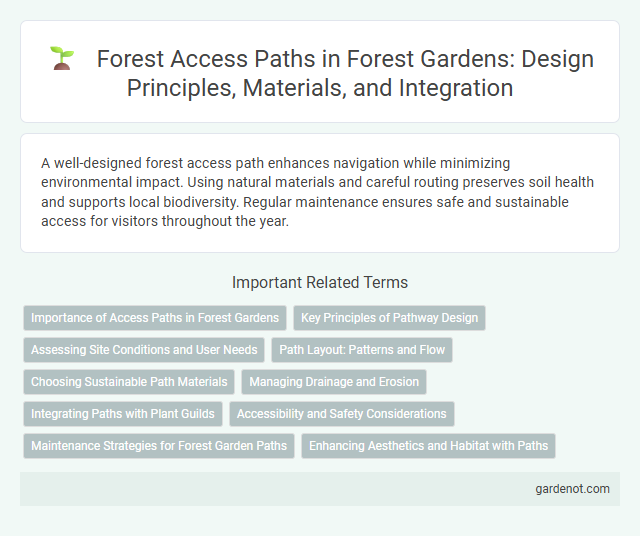A well-designed forest access path enhances navigation while minimizing environmental impact. Using natural materials and careful routing preserves soil health and supports local biodiversity. Regular maintenance ensures safe and sustainable access for visitors throughout the year.
Importance of Access Paths in Forest Gardens
Access paths in forest gardens facilitate efficient movement for maintenance, harvesting, and monitoring, reducing soil compaction and plant damage. Well-designed access paths enhance biodiversity by allowing selective human intervention while preserving native flora and fauna habitats. Properly constructed paths improve airflow and sunlight penetration, promoting overall forest garden health and productivity.
Key Principles of Pathway Design
Forest garden pathway design prioritizes minimal soil compaction and erosion control by selecting permeable materials such as wood chips or gravel to maintain natural water infiltration. Paths follow natural contours to reduce slope gradient, enhancing accessibility and preventing runoff while promoting biodiversity by preserving surrounding vegetation. Strategic width variation accommodates different user needs, ensuring functionality for maintenance equipment and pedestrian access without disturbing ecological balance.
Assessing Site Conditions and User Needs
Evaluating site conditions such as soil type, sunlight exposure, and natural drainage is critical when designing forest access paths to ensure durability and minimal environmental impact. Understanding user needs, including the frequency of visits, accessibility requirements, and safety considerations, guides the selection of appropriate path materials and widths. Incorporating these assessments promotes sustainable forest garden access that supports both ecosystem health and visitor experience.
Path Layout: Patterns and Flow
Forest garden access paths are designed to balance functional flow with ecological harmony, often following natural contours to minimize soil disturbance and promote water infiltration. Path layouts typically incorporate winding or meandering patterns that guide visitors through diverse plant species while maintaining a low-impact footprint. Strategic placement of these paths enhances both accessibility and the overall spatial experience, allowing for efficient harvesting and maintenance without compromising the garden's biodiversity.
Choosing Sustainable Path Materials
Selecting sustainable materials for forest access paths enhances environmental preservation by minimizing soil erosion and protecting native vegetation. Opt for permeable options such as recycled gravel, natural stone, or sustainably harvested wood chips to support water infiltration and reduce runoff. Prioritizing locally sourced materials further decreases carbon footprint while maintaining the forest ecosystem's health and accessibility.
Managing Drainage and Erosion
Forest access paths require careful management of drainage and erosion to maintain soil stability and protect surrounding vegetation. Implementing contour swales, grading, and vegetation buffers effectively diverts water, minimizing runoff velocity and preventing soil displacement. Regular maintenance such as clearing debris and repairing sediment traps ensures long-term durability of access routes in forest garden ecosystems.
Integrating Paths with Plant Guilds
Designing forest access paths involves carefully integrating them with surrounding plant guilds to maintain ecosystem balance and enhance biodiversity. Paths should follow natural contours and avoid disrupting root systems, allowing for seamless interaction between humans and wildlife habitats. Using native mulch and permeable materials supports soil health and complements the surrounding vegetation layers.
Accessibility and Safety Considerations
Designing forest access paths requires careful attention to accessibility by incorporating smooth, non-slip surfaces and gentle gradients to accommodate all visitors, including those with mobility challenges. Safety considerations involve clear signage, proper lighting, and regular maintenance to prevent hazards such as fallen branches or uneven terrain. Strategically placed rest areas enhance comfort and encourage safe exploration within the forest garden environment.
Maintenance Strategies for Forest Garden Paths
Forest garden access paths require regular maintenance strategies such as clearing debris, managing erosion, and trimming overgrown vegetation to ensure safe and easy navigation. Employing natural materials like wood chips or gravel helps improve drainage and durability while blending with the ecosystem. Routine inspections and timely repairs prevent soil compaction and preserve the health of surrounding plants in the forest garden.
Enhancing Aesthetics and Habitat with Paths
Forest access paths enhance the natural aesthetics by using materials like mulch, gravel, or stone to blend seamlessly with the environment. Strategically placed paths minimize soil compaction and protect root systems, promoting healthier plant growth and increased biodiversity. Incorporating native plants and wildlife-friendly features along paths creates vital habitats for pollinators, birds, and small mammals.
Forest access path Infographic

 gardenot.com
gardenot.com